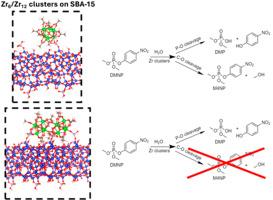Controlling the heterogeneous catalysis of zirconium clusters within a porous SBA-15 scaffold
IF 4.8
3区 材料科学
Q1 CHEMISTRY, APPLIED
引用次数: 0
Abstract
Metal-organic frameworks (MOFs) with Zr-based secondary building units (SBUs) have shown promise as materials for the catalytic degradation of chemical warfare agents (CWAs). The Zr-based SBU within the MOF has been previously determined to be the active site for catalytic hydrolysis reactions within these materials. However, MOF structure dictates access to the SBU active sites with microporous MOFs showing catalysis solely on the surface of the particles of the MOF and MOFs with analogous SBUs exhibiting different reaction rates under the same reaction conditions. The multitude of variables inherent to MOF structures (e.g. pore size, pore structure, connectivity, crystal size, functional groups, defects, and monocarboxylic acid modulators (MCAMs) used in synthesis) complicate the fundamental understanding of the SBU's reactivity in the hydrolysis reaction independent of topological constraints. In this work, we have explored the catalytic activity of a simplified SBU system consisting of Zr6 and Zr12 clusters decorated with MCAMs varying in size and functionality to simulate the chemical environment of the SBU within the MOF structure. The zirconium clusters were then supported on mesoporous silica (SBA-15) functionalized with either sulfuric or phosphoric acid groups that bind to the zirconium nodes, covalently tethering the clusters to the silica support. These novel porous materials were designed to mimic the porous nature of the MOF structure to determine the effect on hydrolysis reactivity. The final silica-bound zirconium clusters showed enhanced reactivity towards the hydrolysis of dimethyl nitrophosphate (DMNP), a nerve agent simulant, under buffered conditions compared to the bare Zr clusters and showed key differences in the catalytic activity based on the chemical environment imparted by both the MCAM and the modified support. In addition, the use of an acid-modified silica scaffolding allowed for the incorporation of adjacent amine moieties on the SBA-15 support to facilitate hydrolysis of DMNP under neutral aqueous conditions, a benefit over typical Zr-based MOF catalysts that require a buffer for appreciable reactivity.

在多孔 SBA-15 支架中控制锆簇的异相催化作用
具有 Zr 基二级结构单元 (SBU) 的金属有机框架 (MOF) 已显示出作为催化降解化学战剂 (CWA) 材料的前景。MOF 中的 Zr 基 SBU 先前已被确定为这些材料中催化水解反应的活性位点。然而,MOF 结构决定了进入 SBU 活性位点的途径,微孔 MOF 仅在 MOF 颗粒表面显示催化作用,而具有类似 SBU 的 MOF 在相同反应条件下显示出不同的反应速率。MOF 结构固有的多种变量(如孔径、孔结构、连通性、晶体尺寸、官能团、缺陷和合成中使用的单羧酸调制剂 (MCAM))使人们对 SBU 在水解反应中的反应性的基本理解变得复杂,而不受拓扑约束的影响。在这项工作中,我们探索了一个简化的 SBU 系统的催化活性,该系统由 Zr6 和 Zr12 团簇组成,并用不同大小和功能的 MCAM 进行装饰,以模拟 SBU 在 MOF 结构中的化学环境。然后将锆簇支撑在介孔二氧化硅(SBA-15)上,介孔二氧化硅上的硫酸基团或磷酸基团可与锆节点结合,从而将簇共价拴在二氧化硅支撑上。设计这些新型多孔材料的目的是模仿 MOF 结构的多孔性,以确定其对水解反应活性的影响。与裸锆簇相比,最终与二氧化硅结合的锆簇在缓冲条件下对神经毒剂模拟物--硝基磷酸二甲酯(DMNP)的水解反应活性有所提高,而且根据 MCAM 和改性支持物所提供的化学环境,其催化活性也存在关键差异。此外,酸改性二氧化硅支架的使用允许在 SBA-15 载体上加入相邻的胺分子,以促进 DMNP 在中性水溶液条件下的水解,这比典型的 Zr 基 MOF 催化剂更有优势,因为后者需要缓冲液才能产生明显的反应活性。
本文章由计算机程序翻译,如有差异,请以英文原文为准。
求助全文
约1分钟内获得全文
求助全文
来源期刊

Microporous and Mesoporous Materials
化学-材料科学:综合
CiteScore
10.70
自引率
5.80%
发文量
649
审稿时长
26 days
期刊介绍:
Microporous and Mesoporous Materials covers novel and significant aspects of porous solids classified as either microporous (pore size up to 2 nm) or mesoporous (pore size 2 to 50 nm). The porosity should have a specific impact on the material properties or application. Typical examples are zeolites and zeolite-like materials, pillared materials, clathrasils and clathrates, carbon molecular sieves, ordered mesoporous materials, organic/inorganic porous hybrid materials, or porous metal oxides. Both natural and synthetic porous materials are within the scope of the journal.
Topics which are particularly of interest include:
All aspects of natural microporous and mesoporous solids
The synthesis of crystalline or amorphous porous materials
The physico-chemical characterization of microporous and mesoporous solids, especially spectroscopic and microscopic
The modification of microporous and mesoporous solids, for example by ion exchange or solid-state reactions
All topics related to diffusion of mobile species in the pores of microporous and mesoporous materials
Adsorption (and other separation techniques) using microporous or mesoporous adsorbents
Catalysis by microporous and mesoporous materials
Host/guest interactions
Theoretical chemistry and modelling of host/guest interactions
All topics related to the application of microporous and mesoporous materials in industrial catalysis, separation technology, environmental protection, electrochemistry, membranes, sensors, optical devices, etc.
 求助内容:
求助内容: 应助结果提醒方式:
应助结果提醒方式:


